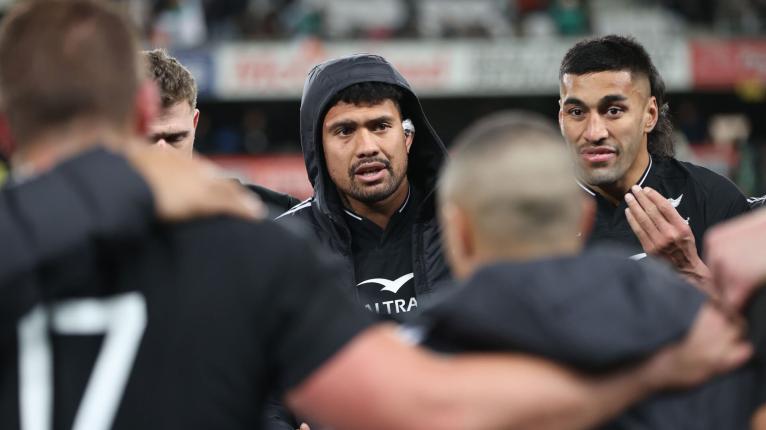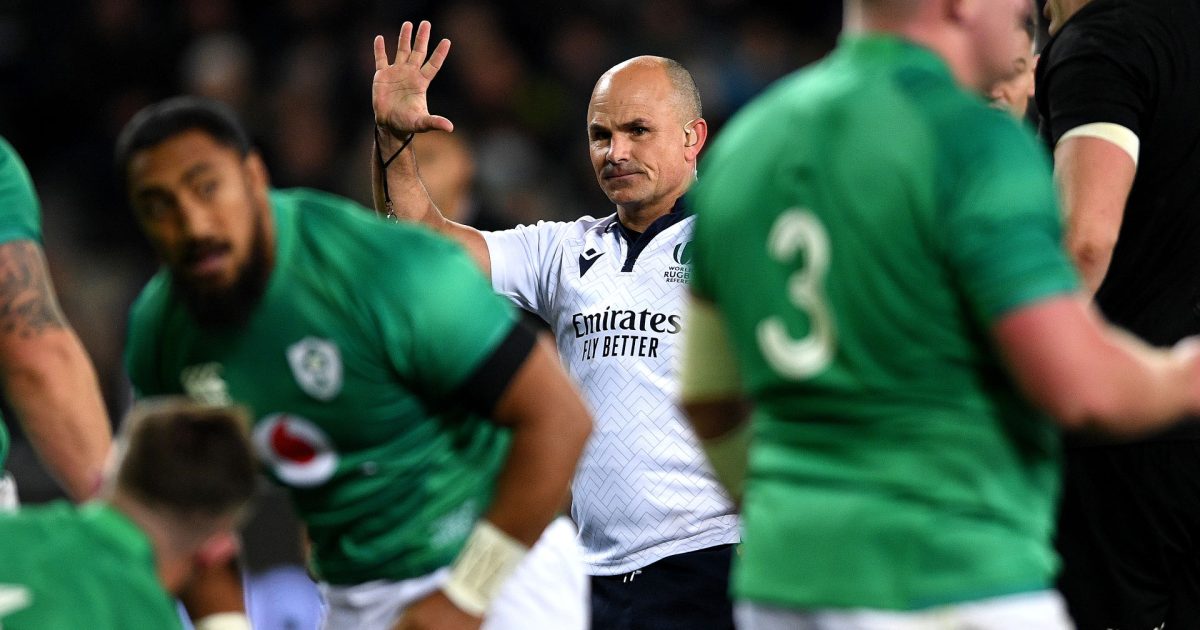Ref Watch: Peyper sees red as cards fly and penalty tries go a begging

Jaco Peyper is one of the most experienced officials in world rugby and he needed to draw on all his skills to handle a test match crammed with incident and controversy which eventually delivered Ireland’s first win in New Zealand – at the fourteenth time of asking.
The head contact protocols make more cards and increased use of the TMO inevitable – at least until players and coaches are able to make significant changes to tackle technique – and referees have also as a result had to adapt.
Red cards used to be a very occasional occurrence and what was perhaps not widely appreciated was the extent to which a referee’s concentration and subsequent performance could be impacted by the unsettling effect of sending a player off. Did I get that right? Could I have done something to prevent it happening? Focusing on the rest of the match rather than dwelling on the red card was a skill in itself.
In the modern world, such are the frequency of these big calls, officials deal with them far more regularly and are therefore less likely to suffer subsequent concentration issues. It is accuracy in both process and outcome which is of greater concern to World Rugby’s elite group of whistlers, so how did Peyper plus TMO and touch judges fare?
Leicester Fainga’anuka yellow card
Towards the end of the opening quarter TMO Tom Foley intervened to ask Peyper to view Fainga’anuka’s late challenge on Mack Hansen.
“He’s never targeting the ball,” Foley advised.
Ireland’s winger was contacted quite some time after he had kicked the ball by Fainga’anuka who had taken off in an attempt to affect a charge-down.
?? "He's lucky to get away with that"
Should Faingaanuku have seen red for this? ? pic.twitter.com/x48udVPqQC
— Sky Sports Rugby Union (@SkySportsRugby) July 9, 2022
In days gone by, because the All Black was already off the ground – and committed – when Hansen kicked the ball, the clash would usually have been deemed accidental.
However, the modern safety-based approach to head contact requires players to be responsible for the outcome of their actions – and not act recklessly – even when intent is not present.
Replays showed that Fainga’anuka’s arm clearly impacted Hansen’s head, which snapped backwards, however this happened after it first contacted the Irishman’s chest. This provided just enough mitigation for the officials to downgrade the card from red to yellow.
“Not a high level of danger,” Peyper concluded, but as Sky’s half-time analysis suggested it was a borderline call.
Possible Ireland penalty try?
Ofa Tu’ungafasi was yellow carded after Foley asked Peyper to take a look at his off-the-ball tackle on Gary Ringrose.
The British Lions centre was on the inside shoulder of the ball carrier around eight metres from the home line when he was taken out.
Given the incident’s proximity to the home try-line a yellow card was inevitable based on the degree of cynicism involved. However, was there also a case for a penalty try?
Peyper viewed the incident from a wider angle and in both slo-mo and real time in an attempt to ascertain whether the All Black cover would have got to Ringrose and decided it would.
The key point here is whether the offence prevented a ‘probable’ (not definite) try. So would Ringrose have probably received a pass, would he probably have caught it and would he have probably reached the line before the cover got to him?
On all available evidence Peyper concluded not – many including myself and co-commentator Alan Quinland who said: “There’s no way anyone’s getting to Ringrose if he gets the pass,” will disagree.
Angus Ta’avai red card
Under the head protocol directives and law as written this is as cast-iron a red card as we will ever see.
The All Black temporary replacement – who was on the field because of by Fainga’anuka’s sin-binning – made no attempt to bend into his tackle on Ringrose and a high-impact clash of heads resulted.
We are watching one of the most bizarre matches in years ? #NZLvIRE pic.twitter.com/QsDhRiM6VM
— RugbyPass (@RugbyPass) July 9, 2022
Peyper and Foley followed the protocol to the letter, checking to see if Ringrose had either dipped in height or changed direction at the last moment, but when no mitigation was present a red card duly followed.
Ardie Savea becomes the fall guy
The officiating that followed then included two errors in process.
With both tight heads now off the field, the next two scrums were uncontested, so as per the incident which affected Italy in the Six Nations, New Zealand should have removed two additional players when they brought on loose head Aidan Ross as a second temporary front row replacement leaving 12 – not 13 – players on the pitch for the brief period until Fainga’anuka returned from the bin.
In addition to blindside flanker Dalton Papalii, who had previously exited to allow Ta’avai to cover for Fainga’anuka, the Kiwis were required to take off only the influential Savea.
Ironically, when Savea then attempted a return to the fray when by Fainga’anuka exited the sin bin he was forced by the officiating team to leave the field since New Zealand then had 15 – instead of 14 – players on the pitch. However, in law it should have been the originally-replaced Papalii who was prohibited from returning to the fray.
In summary this meant New Zealand played around two minutes with 13 instead of 12 players, while Savea rather than Papalii should have been allowed to return.

Scrums help the flow
This was a thrilling match for the neutral, and in no small part this was due to how little time was wasted at the set-piece.
Peyper clearly had the front rows onside with his required engagement process and as a result only one of 17 scrums had to be reset, while 13 completed without the award of a penalty or free kick.
Strong Management
Peyper is not everyone’s cup of tea, but I really like his strong management style. For those who watched James Doleman’s display during last week’s Australia v England game a massive contrast was evident between a rookie international ref and one with many years behind him.
This was perfectly illustrated by the South African’s conversation with New Zealand skipper Sam Cane during the spell when the Kiwi’s had 13 men.
After penalising the hosts for lifting a leg in a defensive maul close to their own line, Peyper told Cane: “You need to have a serious chat, I’m not going to back off.”
A weaker official would not have countenanced reducing New Zealand to 12 players for one or two technical offences immediately after showing a red card – but Peyper made it abundantly clear that he would grant no such leeway.
| Quarter 1 | Quarter 2 | Quarter 3 | Quarter 4 | |
| Pens against NZ | 3 | 4 | 4 | 2 |
| Pens against Ireland | 2 | 7 | 2 | 3 |






































































































Who the f is Ta’avai ?
If we take Foster to World Cup we may as well not go, No plan B just sit and get paid !!!
LOl neither 3.17 or 3.18 implies either behaviours the press keep prattling on And I dont know what happened in Italy cause you know who cares
Not only that but ther e are no specific rules as to what to do in the event 2 props are lost .Who witht all honest could argue the intent of these two laws is to make the team sake 2 players off?.. And if it is why and lets get rid off it surely?
I thought that Ireland could have been awarded a penalty try but after watching the game again this is what happened the player witht the ball shaped to pass didn't cause he saw the other guy was about to get hammered and decided to take the tackle,and the All Balck who had anticipated the pass that never came tried to back out ...Im no sure the man in green didnt dive
Tell me Im wrong But at least you would get no arguements as to if the referee was wrong or not .Everyone whould have been ok if he had decided to award a try
However the other arguments miss the wood for the trees by waffling on about the protocols now and players will have to learn....
The laws are wrong and are ruining the game ..
.You can endless move the camera around to support a view but there's no way the prop was trying to TACKLE anyone and its absurd to claim the other player was not trying to block the ball ,.when a jumper in the lineout falls over and lands on an opposite players head is he sent off .?
The rules suck
Its as simple as that
.And they need to be changed ..
The game was a FARCE
How bout the editor sort out the proper spelling of names?? Ta'avao, not Ta'avai and Fainga'anuku not Fainga'anuka 🤦🏻♂️
In both New Zealand and Australia, refs who were not good enough in the Premiership and URC, became TMOs and tried to dominate the matches. Get rid of them both.
What nonsense. Fainga'anuku wasn't even a penalty. Funny how the TMO was silent when Lowe blatantly took out Barrett with a swinging arm. The match was rigged.
Ref did not handle the 1st half correctly. He was very poor
NZ should have been reduced to 12 for the period when it went to uncontested scrums with the red and yellow car.